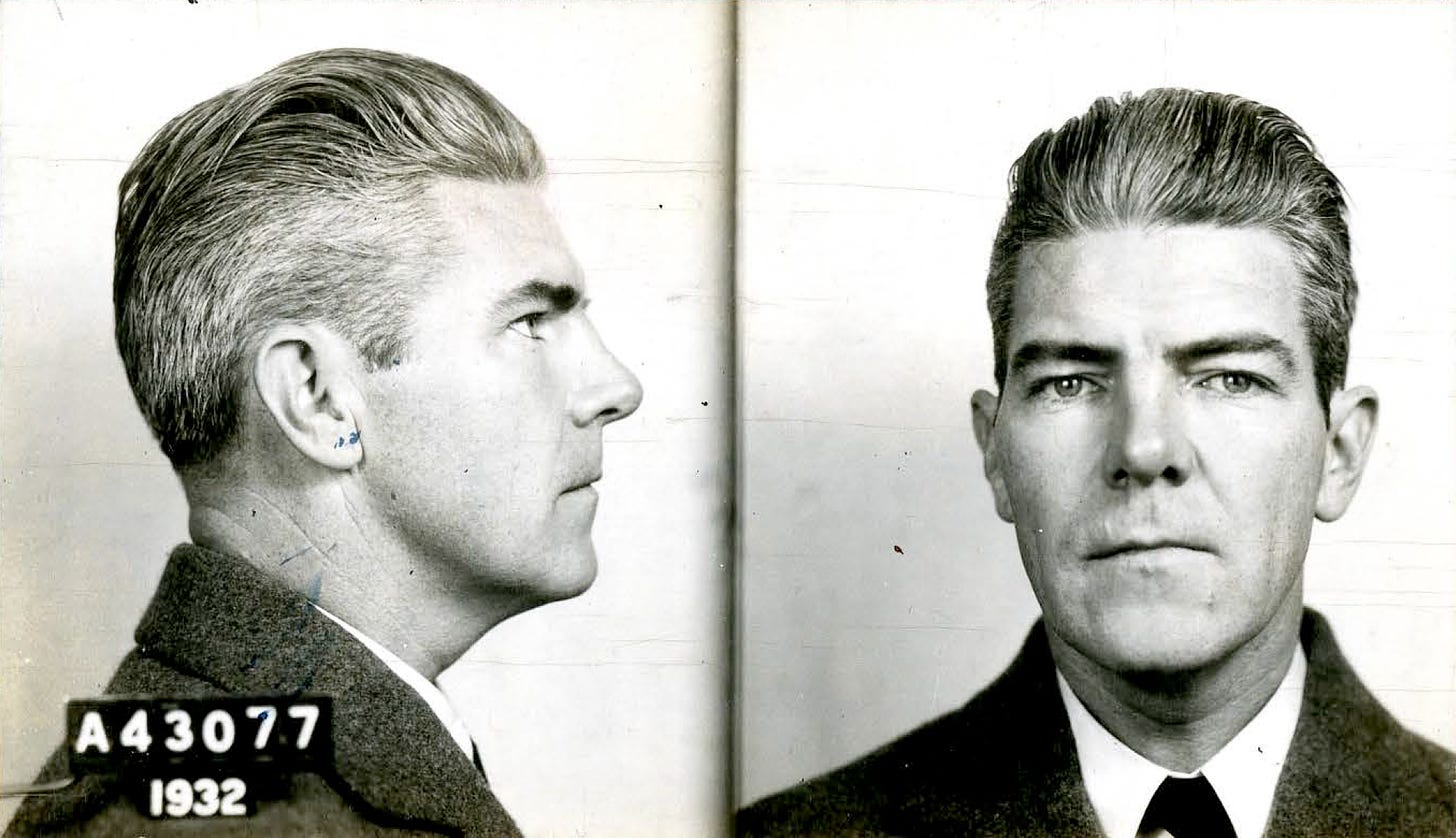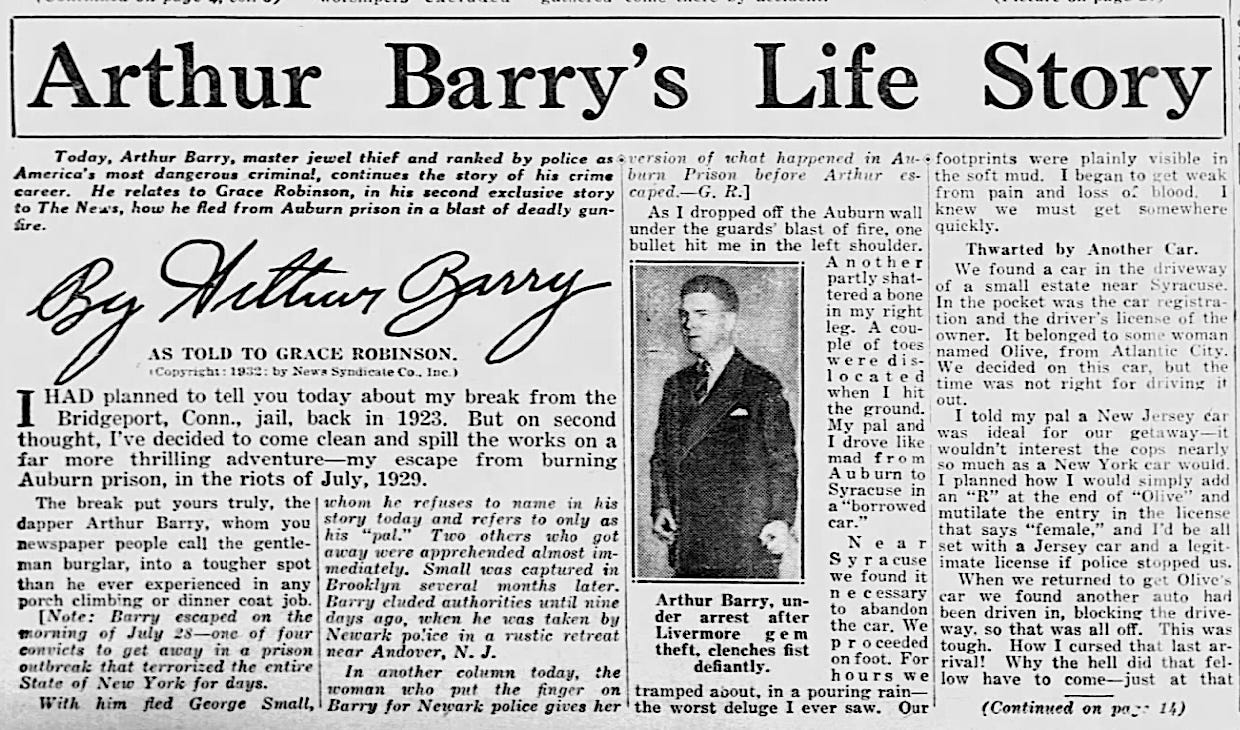Welcome back to SOURCE NOTES. Up next we have Dean Jobb, whose latest page-turner, A GENTLEMAN AND A THIEF: The Daring Jewel Heists of a Jazz Age Rogue, is hot off the presses from Algonquin/Hachette. (Though I spotted it on the shelves of my local Barnes & Noble two weeks ago!) In the spirit of transparency, I should mention that I blurbed this book—“A potent cocktail of high-end grift and Roaring Twenties opulence”—alongside authors more illustrious than I, like Abbott Kahler and David Grann, who raves: “In this mesmerizing tale about a Jazz Age gentlemanly thief, Jobb has found his own perfect jewel.” But enough with the ringing endorsements; let’s get into it.
Let’s start with an overview of the book.
This is the story of a man that Life magazine called “The Greatest Jewel Thief That Ever Lived,” Arthur Barry. His name is not well known today, but it should be. He was like a jazz age Cary Grant. He inserted himself into New York high society, crashed parties, seemed to fit in in his tux. But what he was really doing was casing the mansion so he could come back later, put a ladder up against the window, and steal as many jewels as he could. He was blowing his money, gambling, living the high life, stealing jewels when he needed to, and getting away with it for seven years. He robbed Percy Rockefeller, he robbed the Woolworth five-and-dime store heiress. And one memorable night in 1924, he befriended and partied with the Prince of Wales, the future King Edward VIII. So it's just this rollicking story of Jazz Age excess and this master criminal. Once he's caught, a whole new phase of the story begins.
How did you discover Arthur Barry?
I was between projects, looking for a new idea. I had just done a Victorian-era serial killer, and I had done a previous book called EMPIRE OF DECEPTION about a 1920s Chicago Ponzi-schemer. I was thinking, the Jazz Age is just such a wonderful era and it resonates so much with the 2020s, so maybe I could find something there. So I literally Googled “1920s con artist,” and one of the first hits was a 1950s Life magazine article. I had never heard of this fellow and it was just such an incredible story. I saw that there was one book done by a journalist who had interviewed him and then done a biography in the early sixties. I just was captivated by his daring and his brazenness. But I also thought, this is the kind of anti-hero readers can root for, because he got into some violent scrapes, but he wasn't violent by nature. He was breaking into homes and violating people's privacy. But he was a gentleman to the core, and he was robbing from people who, frankly, could afford it. He said, if a woman can wear a pearl necklace worth three quarters of a million dollars, she's not worried about where her next meal's coming from.
When was it that you started digging into him?
It was during the pandemic, summer 2021.
So at that point, how big was his footprint in the historical public record?
There was the book from the 1960s, and there was a smattering of profiles and sometimes sensationalized articles from the fifties way back into the thirties. The challenge when you're doing a fellow like this, who's good at what he does, is, there was a whole string of robberies that I had to tie him to after the fact, based on allegations, indictments, confessions. He didn’t confess to all his crimes, but over time he did confess to some of his major ones. I was able to go back to the early twenties, places where I knew he was stealing, and I could see his pattern. And enough of them had either been tied to him or he had admitted to, that I was able to string it together.
In other words, you solved some of these unsolved crimes?
I guess you could say that, yeah. And he's not around to dispute it! It was important to me to convey the scale of what he'd done. It was a challenge, but a fun challenge.
Are there any living descendants or distant relatives?
I was able to track down two young cousins who knew him—they were young cousins at the time. Barry lived until 1981 and reformed himself in his old age, and went back to his hometown of Worcester, Massachusetts. And they knew him well. They knew him as their Uncle Artie, a great guy. As they were growing up, they didn't have an idea of this other life. It was sort of an open family secret. Through them, I was able to get a window on his later years. He never spoke publicly, to my knowledge, after about 1961.
Did he participate in that original book from the sixties?
He did. But there were certain things he was hiding. He did not talk at length about his wife. He married a woman named Anna Blake in 1925, and then when he's arrested in 1927, he pleads guilty to one of his major crimes to save her from prison. And then when he broke out of prison in 1929, they lived for three years as fugitives together. This was not well documented in the book. In fact, the cousins didn't realize that their uncle had actually been married. That knowledge had been lost within the family.
Wow.
And there were a few other things. As I did my research, I could sort of see, oh, that's why there's this omission. That's why he claims this. Through True Detective and other pulp magazines, I was able to track down firsthand accounts by the detective and the district attorney who brought Barry to Justice in 1927. The only complete version of Barry's confession that I could find was in one of these magazines.
You were able to obtain police records of his thefts, from various law enforcement agencies in Long Island and Westchester. It’s amazing stuff that like actually still exists.
Well, some of it exists. I was disappointed to find that not much of is exists for Barry. I contacted police museums and historical societies and county archives. It's kind of the luck of the draw. But I did, in Nassau County, find some batches of court records, and they were essential.
But you also did find a few snippets of arrest records and such, right?
Yeah. You just never know. You want to tell the best story you can, the most complete story you can, and you don't want to feel like there's somewhere you should have looked for.
What other archives did you draw on?
The treasure trove for me in this particular case was the New York State Archives in Albany. Barry served time in three prisons. I needed all the intake records, the disciplinary records. I contacted the archives and asked them how I'd go about finding that stuff. It would have been a matter of systematically going through the material, and I offered to hire a researcher. But they said, leave it with us, we'll do what we can. And they just kept coming through with little bits. Over the course of a number of months, they provided hundreds of pages of material, including a mugshot from 1932 which had never been seen. They were just incredible.
Did you find anything in the archives of rich and famous people he conned? Like a Rockefeller or whatever?
I did. In the Mountbatten papers in England, there were scrapbooks that documented the theft of Lady Mountbatten’s jewels that Barry was responsible for. I was also able to trace some of the rich people though through the New Yorker archives.
The New Yorker wrote about the heists?
They did. A writer named Morris Markey.
Of course, the magazine’s original “Reporter At Large.” I actually wrote about him for The New Yorker.
Yeah. He had a special interest in crime writing.
Our books share a minor character in Grace Robinson, the pioneering New York Daily News reporter.
Of course. She's such a fascinating character. I mean, the reverence with which other journalists in their memoirs talk about the lightning speed of her note-taking, her fearlessness. She was one of the top crime reporters by the time she met Barry in 1932. She did a series purporting to be Barry's own true story. I mean, she's in there lighting his cigar, because he’s shackled to his chair during the interview. But she did not just let him sit there and fill her notebooks. She challenged him. He made it sound like he had no juvenile records. But she had his juvenile records. She did a brilliant job of extracting the story that a tabloid would want of this master criminal.
How big of a tabloid story was Arthur Barry?
The Daily News ate it up, and the Daily Mirror. With the 1925 Plaza Hotel robbery, there was huge coverage, and the Daily News was at the leading edge of it. But I mean, these were also front page New York Times stories
You were researching at home in Nova Scotia during the thick of COVID. Did you get to visit any physical settings from the book?
No, I didn't. I did some Google Street View virtual visits, of course. Also, so many of the mansions where Barry did his crimes, although they were beautiful, magnificent buildings, over the course of time they were knocked down. Percy Rockefeller's estate was knocked down in the fifties, I believe, and the land was subdivided. I wish I could have been in the courthouses, and the prisons obviously are all still there. It would've been nice.
Your next book has already been announced. Are you knee deep in it?
I am. It's a book called MURDER IN THE CARDS, and it’s a story I think you know about the 1920s Bridge expert Joe Elwell, who was found murdered in his home.
I know it well. I’ve researched it for a potential future non-book something or other.
I'm going to write it like a real life whodunnit. I've already got a pretty good idea, I think, of why he was murdered and how he was murdered. I’m going to aim to solve the case to the best of my ability.








